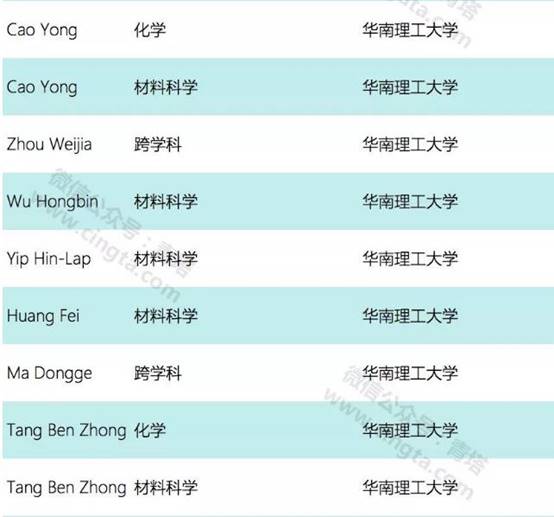Recently, Clarivate Analytics has published its Highly Cited Researchers 2018 list. 13researchers from SCUT have been selected into the list, of which 9researchers used SCUT as the unit of the first author. This number hits a record high and ranks tenth in mainland.
Five researchers from SMSE(School of Materials Science and Technology), SCUT Cao Yong, Tang Ben Zhong, Yip Hin-Lap, Wu Hongbin, and Huang Fei, were selected as “Highly Cited Researchers” in the field of materials science. When ranked by the number of highly cited researchers in material science, SUCT was tied with Tsinghua University and Soochow University on the first place in mainland and on the third place in globe, approaching that of Stanford University and Nanyang Technological University of Singapore. In addition, Cao Yong and Tang Ben Zhong were selected as Highly Cited Researchers in Chemistry. Ma Dongge was selected as Highly Cited Researcher in interdisciplinary field.

Researchers from SCUT on the “Highly Cited Researchers 2018” list.
In recent years, driven by the Double-First Class initiative, SMSE continuously improve its management policy and enhance its innovation capabilities. Therefore, the quantity and quality of scientific papers achieved rapid growth. In 2017, SMSE has published 744 papers in three major indexes, including 629 SCI papers, 89 EI papers and 26 CPCI papers. Based on ESI updated in November 2018, SMSE has 186 highly cited papers, 103 of them used SCUT as the unit of the first author. This number accounted for 37.2% of the universities' highly cited papers and was on the first spots in SCUT. SMSE has so many highly cited researchers that it highlights the academic influence of SCUT's materials disciplines in the country and around the world, especially in the field of optoelectronic materials.
The list of highly cited scientists has been published for five consecutive years. Using the Essential Science Indicators(ESI)database, the list identifies influential researchers by citation analysis and their developmental tendency. In 2018, totally 6000 researchers from 21 scientific fields has been selected into the list, 554 of them come from China (including Hong Kong, Macao and Taiwan).
Brief introduction of highly cited researchers from SMSE:
Cao Yong
Cao Yong, academician of Chinese Academy of Sciences. He was born in 1941 and graduated from the School of Chemistry of Saint-Petersburg State University in 1965. In 1987, he received his Ph.D degree from the University of Tokyo, Japan. After that, he worked at the Institute of Chemistry of the Chinese Academy of Sciences, focusing on the research of PLED electroluminescence devices and the relationships between structural and performance of conductive polymers and organic metal conductors. During 1988 to 1998, he worked as a senior researcher in UCSB and in UNIAX company. Since 1998, he became the director of the State Key Laboratory of Luminescent Material and Devices, SCUT and mainly engaged in organic photoelectric materials, devices and their system integration research.
Tang Ben Zhong
Tang Ben Zhong, academician of Chinese Academy of Sciences. He graduated from SCUT in 1965. He is currently the dean of SCUT-HKUST Joint Research Institute, SCUT and the Director of Academic Committee of the State Key Laboratory of Luminescent Material and Devices, SCUT. He mainly engaged in the research of polymer chemistry and photoelectric functional materials. He created the concept of Aggregation-Induced Emission (AIE) and is a leader in this field.
Ma Dongge
Born in 1967, Ma Dongge received his Ph.D. in Science from Jilin University in 1995. He is a Professor and supervisor of Ph.D. in School of Materials Science and Engineering, SCUT. His main research fields are organic light-emitting diodes and their applications, organic photodetectors and applications, organic magnetic field effects and spintronic devices, and organic semiconductor transport and heterojunction theory. He has been engaged in the research of organic optoelectronics and organic spintronics for many years, and has made outstanding achievements in white-light OLED and its applications.
Wu Hongbin
Wu Hongbin was born in 1976 and received his Ph.D. from South China University of Technology in 2006. He has been engaged in the research of organic/polymer optoelectronic materials and devices for a long time, and has made a series of achievements in the fields of organic light-emitting devices, solar cells and photodetectors. He has published more than 190 academic papers and being cited for more than 6000 times.
Huang Fei
Huang Fei was born in 1979 and he received his bachelor's degree from School of Chemistry and Molecular Engineering, Peking University in 2000. In 2005, he received his Ph.D. from the School of Materials Science and Engineering, South China University of Technology. He is deputy director of the State Key Laboratory of Luminescent Materials and Devices and Professor of the School of Materials Science and Engineering, South China University of Technology. He is mainly engaged in the research of Organic Polymer Optoelectronic Materials and devices and has made a series of innovative achievements in new water-alcohol-soluble interface materials and interface control methods, and in new polymer photovoltaic materials and devices.
Yip Hin-Lap
Born in 1979, Yip Hin-Lap received his Ph.D. in the Department of Materials Science and Engineering, Washington University, USA, in 2008. He is a Professor at the School of Materials Science and Engineering, South China University of Technology. His main research direction is to improve the performance of polymer and perovskite optoelectronic devices by using materials, optics, interface and device engineering strategies. He made significant achievements in the research of translucent and laminated solar cells. Organic translucent photovoltaic cells which can insulate and generate electricity have been realized, and their multi-functional integrated application demonstration has been greatly promoted.





